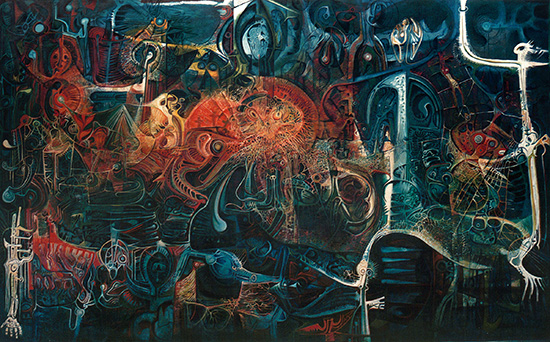Art and Value
16/04/12 23:24 Filed in: Business
Art + Value at NAPA
Published in the Business Guardian on April 05, 2012.
Story and photographs by Mark Lyndersay

Leroy Clarke's Weavers of the Dust. Photograph by Mark Lyndersay
The Art Society filled a small auditorium at NAPA with its most recent panel discussion, a conversation around Price, Value and the Visual Arts.
Nobody could have realistically expected something concrete to come out of the March 10 event. There were no recommended prices agreed on and no standards proposed for deciding the value of art, but there were lots of discussions about the role that art should play in society.
 In his opening comments to the audience gathered for the event, artist Kenwyn Crichlow noted that: “Artists have come to believe that collectors, corporations, gallery directors and people who buy art will or should pay whatever is asked for a picture. When they do not, or ask for a discount, artists often feel let down, or unsuccessful.”
In his opening comments to the audience gathered for the event, artist Kenwyn Crichlow noted that: “Artists have come to believe that collectors, corporations, gallery directors and people who buy art will or should pay whatever is asked for a picture. When they do not, or ask for a discount, artists often feel let down, or unsuccessful.”
“The underlying issues of art and its relationship to money as a measure of value remain a source of tension and misunderstanding of the preciousness of artistic sensibility to the community.”
 If there was any agreement on the issue of price and value in the creation and sale of art, it all revolved around a quote by art critic Clement Greenberg that Crichlow seeded into the discussion early, “A fair price for a work of art is whatever someone is willing to pay for it.”
If there was any agreement on the issue of price and value in the creation and sale of art, it all revolved around a quote by art critic Clement Greenberg that Crichlow seeded into the discussion early, “A fair price for a work of art is whatever someone is willing to pay for it.”
A counter quote to that came later on from Medulla Art Gallery owner Geoffrey Maclean who shared a bit of vintage Pat Bishop with the audience, “We know the price of everything and the value of nothing.”
The discussion would proceed between these two perspectives, for much of the evening.
First to be scrutinised was the notion of value.
Maclean introduced the conversation about value by noting that art has both an intrinsic and a commercial value. Economist Ronald Ramkissoon further identified symbolic, aesthetic, emotional, cultural and historical elements in the market value of any work of art.
 Citing economist Michael J Mandel, Ramkissoon floated the notion that when it comes to art, there is no normal supply curve, only demand matters.
Citing economist Michael J Mandel, Ramkissoon floated the notion that when it comes to art, there is no normal supply curve, only demand matters.
“When it comes to pricing art,” asked Ramkissoon, “we must ask if this [the elements of value] is important. If so, why and to whom is it important? How do we know if we have arrived at the right price? To whom is art considered important?”
Most of these questions were destined not to be answered at the Art Society’s ambitious forum, but many aspects of them were addressed.
Nimah Zukari, curator of the National Museum and Art Gallery offered a narrative of the process the institution followed in acquiring two major works, LeRoy Clarke’s Weavers of the Dust and Carlisle Chang’s Folk Festivals.
 Clarke’s work had been on loan to the museum for 23 years before it was finally bought for $1.2 million in 2007. In 2010, a private owner offered the museum Chang’s painting, held and displayed at the BelAir Hotel for decades. The work was acquired for $500,000.
Clarke’s work had been on loan to the museum for 23 years before it was finally bought for $1.2 million in 2007. In 2010, a private owner offered the museum Chang’s painting, held and displayed at the BelAir Hotel for decades. The work was acquired for $500,000.
Describing the Chang work as “a serious find” and no doubt accepting that the museum’s long term attachment to the Clarke work constituted an acceptable courtship; both works were reviewed by independent valuators whose suggested prices for the works, which were then reviewed by the museum’s Acquisitions Committee.
Prices were selected and offered to the owners of the artworks and on acceptance of the offers; Cabinet approval was sought for the purchases. Both work exceeded the museum’s acquisitions budget of $300,000 annually and the curator’s authorisation limit of $20,000.
 Resale value played a part in LeRoy Clarke’s low-keyed, deeply personal presentation. Clarke sold his first painting in 1965 at his first major showing, Fragments of a spiritual.
Resale value played a part in LeRoy Clarke’s low-keyed, deeply personal presentation. Clarke sold his first painting in 1965 at his first major showing, Fragments of a spiritual.
Noting that a collector who bought his work Span at that showing for a sum that didn’t get into three figures had resold the work recently for $12,000, “He should have bought me a bottle of scotch,” Clarke said, his voice rumbling wryly, “Hell, he should have bought me a case!”
Panelists warned that art doesn’t always appreciate. Styles can become unfashionable. The quality of an overall body of work can dilute the value of early pieces.
“The price can drop,” Ronald Ramkissoon asked, “but does it lose value?”
The collector’s perspective in art buying was represented by Senior Counsel Stephanie Daly who offered commonsense advice to dealers about how they might cultivate relationships with regular buyers by encouraging discussions and engagements beyond the actual sale.
 “The seller,” she noted, “can’t ask the real questions; can you afford it, are you the decision -maker, do you have any taste at all?”
“The seller,” she noted, “can’t ask the real questions; can you afford it, are you the decision -maker, do you have any taste at all?”
Of her own notable collection she asked, “Is it the purchase of the first piece, or the first you buy that you don’t have room for, that you realise that your heart overreaches your head?”
Daly’s first serious purchase was in 1974, a commissioned piece by Pat Chu Foon, one that remains rich in sentimental value, an element of the value proposition which she noted hadn’t been a part of the discussions so far.
Buying many works at Art Society shows, Daly emphasised that she bought what she liked and what was available to her.
Acknowledging her enthusiasms for surrounding herself with art, Daly observed that after running her personal accounts in Quicken, a popular personal finance programme, she realised that she was spending almost all her money on paintings. After reclassifying them as investments in the software; however, she the reports declared her to be a prudent spender.
Encouraging such investments arose intermittently in the discussions. Corporations get a two million dollar tax break for investing in art, but why, Daly asked, should a private collector pay more than a corporation?
 Ronald Ramkissoon called for a study into the visual arts as an economic sector and the need for measurement of its value.
Ronald Ramkissoon called for a study into the visual arts as an economic sector and the need for measurement of its value.
“How much does art contribute to the GDP,” he asked.
The panel discussion raised questions beyond strict matters of price and encouraged several queries worthy of exploration if art is to enjoy more consistent valuation, and the market is to mature into one that engages global venues and collectors as well.
From the perspective of the creators, the burden of creating a career, building skills and developing a market for creative work still rests heavily on individual artists.
“We don’t have any institutions to support artists on the way to becoming an artist,” said LeRoy Clarke.
“It does not take much to see the difficulty of setting up an artistic practice,” said artist Kenwyn Crichlow.
“It is ironic that the burden of these costs are referred to as ‘paying one’s dues,’ another seductive lie that visual artists today would do well to reconsider.”
“Let us invest in the spectacle of our dreams, they might tell us something of the human condition.”
Published in the Business Guardian on April 05, 2012.
Story and photographs by Mark Lyndersay

Leroy Clarke's Weavers of the Dust. Photograph by Mark Lyndersay
The Art Society filled a small auditorium at NAPA with its most recent panel discussion, a conversation around Price, Value and the Visual Arts.
Nobody could have realistically expected something concrete to come out of the March 10 event. There were no recommended prices agreed on and no standards proposed for deciding the value of art, but there were lots of discussions about the role that art should play in society.

“The underlying issues of art and its relationship to money as a measure of value remain a source of tension and misunderstanding of the preciousness of artistic sensibility to the community.”

A counter quote to that came later on from Medulla Art Gallery owner Geoffrey Maclean who shared a bit of vintage Pat Bishop with the audience, “We know the price of everything and the value of nothing.”
The discussion would proceed between these two perspectives, for much of the evening.
First to be scrutinised was the notion of value.
Maclean introduced the conversation about value by noting that art has both an intrinsic and a commercial value. Economist Ronald Ramkissoon further identified symbolic, aesthetic, emotional, cultural and historical elements in the market value of any work of art.

“When it comes to pricing art,” asked Ramkissoon, “we must ask if this [the elements of value] is important. If so, why and to whom is it important? How do we know if we have arrived at the right price? To whom is art considered important?”
Most of these questions were destined not to be answered at the Art Society’s ambitious forum, but many aspects of them were addressed.
Nimah Zukari, curator of the National Museum and Art Gallery offered a narrative of the process the institution followed in acquiring two major works, LeRoy Clarke’s Weavers of the Dust and Carlisle Chang’s Folk Festivals.

Describing the Chang work as “a serious find” and no doubt accepting that the museum’s long term attachment to the Clarke work constituted an acceptable courtship; both works were reviewed by independent valuators whose suggested prices for the works, which were then reviewed by the museum’s Acquisitions Committee.
Prices were selected and offered to the owners of the artworks and on acceptance of the offers; Cabinet approval was sought for the purchases. Both work exceeded the museum’s acquisitions budget of $300,000 annually and the curator’s authorisation limit of $20,000.

Noting that a collector who bought his work Span at that showing for a sum that didn’t get into three figures had resold the work recently for $12,000, “He should have bought me a bottle of scotch,” Clarke said, his voice rumbling wryly, “Hell, he should have bought me a case!”
Panelists warned that art doesn’t always appreciate. Styles can become unfashionable. The quality of an overall body of work can dilute the value of early pieces.
“The price can drop,” Ronald Ramkissoon asked, “but does it lose value?”
The collector’s perspective in art buying was represented by Senior Counsel Stephanie Daly who offered commonsense advice to dealers about how they might cultivate relationships with regular buyers by encouraging discussions and engagements beyond the actual sale.

Of her own notable collection she asked, “Is it the purchase of the first piece, or the first you buy that you don’t have room for, that you realise that your heart overreaches your head?”
Daly’s first serious purchase was in 1974, a commissioned piece by Pat Chu Foon, one that remains rich in sentimental value, an element of the value proposition which she noted hadn’t been a part of the discussions so far.
Buying many works at Art Society shows, Daly emphasised that she bought what she liked and what was available to her.
Acknowledging her enthusiasms for surrounding herself with art, Daly observed that after running her personal accounts in Quicken, a popular personal finance programme, she realised that she was spending almost all her money on paintings. After reclassifying them as investments in the software; however, she the reports declared her to be a prudent spender.
Encouraging such investments arose intermittently in the discussions. Corporations get a two million dollar tax break for investing in art, but why, Daly asked, should a private collector pay more than a corporation?

“How much does art contribute to the GDP,” he asked.
The panel discussion raised questions beyond strict matters of price and encouraged several queries worthy of exploration if art is to enjoy more consistent valuation, and the market is to mature into one that engages global venues and collectors as well.
From the perspective of the creators, the burden of creating a career, building skills and developing a market for creative work still rests heavily on individual artists.
“We don’t have any institutions to support artists on the way to becoming an artist,” said LeRoy Clarke.
“It does not take much to see the difficulty of setting up an artistic practice,” said artist Kenwyn Crichlow.
“It is ironic that the burden of these costs are referred to as ‘paying one’s dues,’ another seductive lie that visual artists today would do well to reconsider.”
“Let us invest in the spectacle of our dreams, they might tell us something of the human condition.”
blog comments powered by Disqus